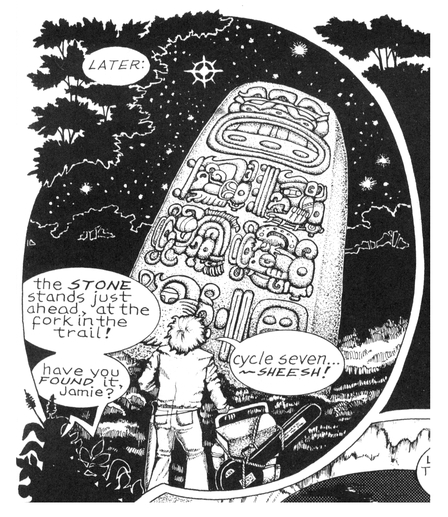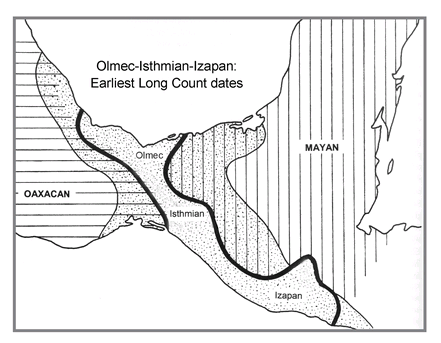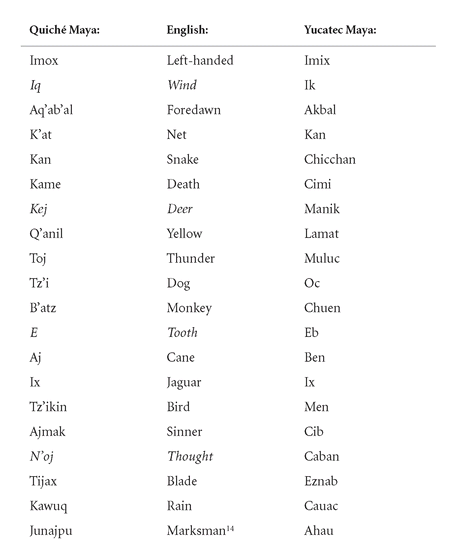The 2012 Story (10 page)
Authors: John Major Jenkins

Continuing farther down the Pacific coast from Tak’alik Ab’aj, a well preserved late Cycle 7 monument at El Baúl clearly reads 7.19.15.7.12 (March 2, 37 AD). Stela 5 from Tak’alik Ab’aj contains two Long Count dates; one is clearly 126 AD and the other is either 83 AD or 103 AD. Farther to the north but within the region known as the Isthmus of Tehuantepec, the site of Cerro de las Mesas contains two early Cycle 8 dates.
5
La Mojarra Stela 1, inscribed in “the Isthmian script,” contains Long Count dates corresponding to 143 AD and 156 AD.
6
Linda Schele was able to date the Hauberg Stela with astronomical references in its inscription to March of 197 AD (Long Count 8.7.17.14.4).
7
5
La Mojarra Stela 1, inscribed in “the Isthmian script,” contains Long Count dates corresponding to 143 AD and 156 AD.
6
Linda Schele was able to date the Hauberg Stela with astronomical references in its inscription to March of 197 AD (Long Count 8.7.17.14.4).
7
However far back the Long Count’s origins may go, something definite happened in the middle of the first century BC—it was carved in stone. As scholar Prudence Rice said, “time became materialized.”
8
The willingness to commit the calendar to stone could be considered analogous to images of the Buddha, which only began to appear hundreds of years after he lived. Before that, it was forbidden. However, we can’t even be sure that there wasn’t a previous legacy of uncarved Long Count records written on perishable bark paper. But the material evidence, assessed at face value, suggests an appearance of the tradition in the first century BC.
8
The willingness to commit the calendar to stone could be considered analogous to images of the Buddha, which only began to appear hundreds of years after he lived. Before that, it was forbidden. However, we can’t even be sure that there wasn’t a previous legacy of uncarved Long Count records written on perishable bark paper. But the material evidence, assessed at face value, suggests an appearance of the tradition in the first century BC.

“Cycle 7” (355 BC to 41 AD)
.
Drawing by Barbara MacLeod
.
Drawing by Barbara MacLeod
As for where this occurred, the locations of the earliest Long Count dates embrace a rather large region of southern Mexico, stretching through the Isthmus of Tehuantepec south along the Pacific coast (a region called Soconusco) and into the steep coastal piedmont of Guatemala. The southern part of this Isthmian region was home to a pre-Maya culture called by Michael Coe “the Izapan civilization.”
9
9

The Isthmian region, origin of the Long Count. After Rice (2007)
Vincent Malmström emphasized that Izapa is situated at an important latitude, 15° North. Within the tropics, the sun can pass through the zenith, the exact center of the sky overhead. It does so at high noon on two days every year, but the exact days depend on your latitude. It just so happens that at Izapa, the solar zenith transit dates are May 1 and August 12. These dates divide the year into 105- and 260-day sections. Furthermore, August 12 is within a day of the zero date of the 13-Baktun cycle of the Long Count. Izapa’s latitude thus highlights the 260-day period and the zero date (or “base” date) of the Long Count. For these reasons, Malmström and other scholars believe that Izapa was the origin place of the 260-day tzolkin as well as the Long Count calendar.
10
10
The Izapan civilization was transitional, between the Olmec and the Maya. Its origins can be traced back to overlap with the Olmec, around 600 BC, and its end came around 100 AD as it transitioned into early Maya forms. Many sites belonging to the Izapan cultural sphere have been known and studied for decades, among them El Baúl, Tak’alik Ab’aj, Kaminaljuyu, and Chiapa de Corzo. Very early sites are now being uncovered, dating to 1000 BC, including La Blanca and Paso de la Amada, which may have given birth to the Izapan culture. But the ritual and ceremonial centerpiece of the Izapan civilization is the site called Izapa, located in southern Chiapas a short distance from the Guatemalan border. Its first monuments were carved around 400 BC. Within the Izapan civilization’s considerable sphere of influence, the first Long Count dates are found.
Cultural changes, historical processes, and the genesis of calendrical traditions are always a lot more complicated than we would hope, and to say that Izapa gave birth to the Long Count may be overly simplistic. In this chapter it’s not all that critical, as we are tracing the entire career of the Long Count. In Chapter 4 we’ll see that, according to my theory, Izapa preserves an astronomy-based mythology that points us directly to 2012. Suffice it to say that the earliest Long Count dates appear in the first century BC and it is likely that the Isthmian region and the Izapan civilization gave rise to the calendars. As Michael Coe said, “The priority of Izapa in the very important adoption of the Long Count is quite clear cut.”
11
It’s interesting to note that the development of hieroglyphic writing accelerated as the adoption of the Long Count spread.
11
It’s interesting to note that the development of hieroglyphic writing accelerated as the adoption of the Long Count spread.
On the fascinating Stela 5 from Tak’alik Ab’aj, Izapan figures are engaged in a ritual with other figures that are clothed differently. Archaeologists believe it represents a transfer of power from Izapa to Tak’alik Ab’aj, complete by the monument’s final Long Count date, 126 AD.
12
The dawn of Maya civilization was beginning. Today, Maya day-keepers (those who track the 260-day tzolkin calendar) do rituals and burn incense in front of this monument. By 126 AD, Izapa was basically frozen in time. Instead of its monuments being ritually destroyed, as often happened, the site was preserved and was likely a pilgrimage destination over the centuries.
13
Many of its sixty carved monuments depict various episodes from the Maya Creation Myth. For two reasons, the site apparently was intended to provide initiations into cosmological knowledge and shamanic mysteries. Initiatory teaching stories about the three cosmic centers were elaborated in the three main monument groups and traditional tools of initiatory rites, powerful hallucinogens found in toads and mushrooms, were used by the shamans at Izapa. This is clear from the Bufo marines toad depicted on Stela 6, which secretes a fluid containing the powerful hallucinogen 5-MEO-DMT, as well as the many ritual mushroom stones found in the region.
12
The dawn of Maya civilization was beginning. Today, Maya day-keepers (those who track the 260-day tzolkin calendar) do rituals and burn incense in front of this monument. By 126 AD, Izapa was basically frozen in time. Instead of its monuments being ritually destroyed, as often happened, the site was preserved and was likely a pilgrimage destination over the centuries.
13
Many of its sixty carved monuments depict various episodes from the Maya Creation Myth. For two reasons, the site apparently was intended to provide initiations into cosmological knowledge and shamanic mysteries. Initiatory teaching stories about the three cosmic centers were elaborated in the three main monument groups and traditional tools of initiatory rites, powerful hallucinogens found in toads and mushrooms, were used by the shamans at Izapa. This is clear from the Bufo marines toad depicted on Stela 6, which secretes a fluid containing the powerful hallucinogen 5-MEO-DMT, as well as the many ritual mushroom stones found in the region.
Stela 29 from Tikal contains a completely fleshed-out Long Count date, corresponding to 292 AD. It is written with the full Calendar Round and Long Count positions according to the Tikal haab system. It has often been called “the first Maya Long Count date
14
and was, in fact, used to define the onset of the Maya Classic Period (300 AD). But thereby calling it the first Maya date is circular and misleading (like saying “the car is mine because it belongs to me”). It gives the unsuspecting reader the impression that there were no real Long Count dates prior to this. This perspective is obsolete considering all the previous Long Count dates just overviewed.
14
and was, in fact, used to define the onset of the Maya Classic Period (300 AD). But thereby calling it the first Maya date is circular and misleading (like saying “the car is mine because it belongs to me”). It gives the unsuspecting reader the impression that there were no real Long Count dates prior to this. This perspective is obsolete considering all the previous Long Count dates just overviewed.
At Tikal, the Long Count was used for a very long time, up into the ninth century AD. As other sites adopted the Long Count, its functions embraced more than just timekeeping. It was inextricably interwoven with kingship, astronomy, building dedications, sacrifice and renewal rites, warfare, mythology, huge distance-number calculations, and ritually timed ceremony. Given the Long Count’s multifarious applications, this would be a good time to get a handle on the basics of how the Maya calendar system works.
The three main components of the system are the 260-day tzolkin, the 365-day haab, and the 20-base Long Count system. A study of these various calendars and day-counts, with their attendant deities and ceremonies, could keep us busy for many years. The tzolkin, the haab, the Calendar Round, and the Venus Round comprise one coherently integrated system of timekeeping, astronomy, and theological beliefs and was used by both the Maya and the Central Mexican cultures, including the Aztecs. None of these calendars, however, are responsible for the famed 2012 cycle-ending date. The cycle ending in 2012 is an artifact of a uniquely Maya calendar called the Long Count. This is fact numero uno of the 2012 topic, in light of which the many designer systems that modern authors are inventing should be taken with a rather large grain of salt.
CALENDAR SYSTEM BASICSThe keystone of the Mesoamerican calendar system is the 260-day tzolkin (a term derived from the Quiché Maya term
chol-qih
, “count of days”). The tzolkin consists of 13 numbers and 20 day-signs. Each day-sign has an oracular meaning, with many layers of linguistic puns and cultural references that provide a rich database for Maya calendar priests to weave their interpretations. The special role of the calendar priest in Maya culture was, and is, to track and interpret the days of the sacred tzolkin calendar, to do ceremony at shrines, offer prayers to the ancestors, and consult with clients on personal and community matters.
chol-qih
, “count of days”). The tzolkin consists of 13 numbers and 20 day-signs. Each day-sign has an oracular meaning, with many layers of linguistic puns and cultural references that provide a rich database for Maya calendar priests to weave their interpretations. The special role of the calendar priest in Maya culture was, and is, to track and interpret the days of the sacred tzolkin calendar, to do ceremony at shrines, offer prayers to the ancestors, and consult with clients on personal and community matters.
The 260-day tzolkin calendar first appears in the archaeological record around 600 BC, and it is still being followed today in the remote villages of highland Guatemala. The thirteen numbers provide three levels of qualities that affect the intensity of the day-sign. Numbers 1-4 are mild, 5-9 are neutral, and numbers 10-13 are intense. The twenty day-signs in the surviving Quiché Maya calendar have the following meanings:

The Yucatec Maya day-sign words are given in the third column, since those are often used as a standard reference. Notice that the Quiché and Yucatec words are often different. This does not mean that the calendars followed were essentially different, as some have presumed. The day-signs use different words in different languages, just as our calendar’s weekday names are different in different languages. For example, Lunes (Spanish) equals Monday (English). The important thing to be aware of is that the same placement of the tzolkin was followed throughout Mesoamerica prior to the Conquest. Calendar priests in Central Mexico, Yucatán, and Guatemala were following the same day-sign placement. The tradition stemmed from the same root and spread in an unbroken fashion throughout Mesoamerica. At the time of the Conquest, day-keepers in widely separate regions were essentially following the same tzolkin placement.
Also notice in the table above that four of the day-signs are italicized. These are the four Year Bearers, the four day-signs that can inaugurate a New Year. The Year Bearers arise when the tzolkin interfaces with the 365-day year. The 365-day vague year, or haab, scheduled mundane agricultural events and festivals. Together with the tzolkin, it is an essential component of the calendar system known as the Calendar Round. Notice here that the smaller cycles combine to generate larger metacycles—an indication that the Maya thought of time as taking the form of harmonically nested cycles.
A Calendar Round is completed when the tzolkin and haab come back to their starting points together, which takes 18,980 days (13 days less than 52 solar years). All of the combinations of tzolkin and haab are then exhausted, and ritual observances in the New Fire ceremony occurred to facilitate the renewal of time. The 365-day haab is a vague approximation of the solar year, which is about one-quarter of a day longer. For this reason, New Year’s Day falls back one day every four years. It is clear, however, that the Maya allowed this to happen for calculational purposes, while at the same time they were aware of the precise length of the solar year by way of their “year drift formula” (in which 1,507 solar years = 1,508 haab).
There are four Year Bearers because the five-day “extra” month in the haab makes each successive New Year’s Day toggle forward five days in the tzolkin. Since there are twenty day-signs, it takes four of these five-day leaps to return to the first Year Bearer; thus, four Year Bearers. The Year Bearers symbolize the four directions, the four quarters of the year (two equinoxes and two solstices), and the four sacred mountains. Of the four Year Bearers one is chief, and in the earliest calendar system the chief Year Bearer was symbolically associated with the December solstice, because that is the most important turnabout day in the year, when the light returns and the sun is reborn. For the modern Quiché Maya the chief Year Bearer is Kej (Deer). A Calendar Round (roughly 52 years) is completed when the chief Year Bearer cycles through the 13 numbers until it once again has a 1 coefficient. The next Quiché Calendar Round begins on 1 Deer, February 18, 2026. This means that the present Calendar Round began on 1 Deer on March 3, 1974.
Other books
Child of Grace (Love Inspired) by Hannon, Irene
He Who Fears the Wolf by Karin Fossum
One Heart to Give (Heart's Intent Book 1) by Brower, Dawn
Black Widow by Randy Wayne White
What Dreams May Come by Matheson, Richard
Haunted Destiny: A Midnight Dragonfly Bonus Short Story by James, Ellie
Broken Forest: Book One of the Daath Chronicles by Tilton, Eliza
DragonGames by Jory Strong
Save the Children by Don Pendleton
El asesino de Gor by John Norman